“Things end. That’s all. Everything ends, and it’s always sad. But everything begins again too, and that’s always happy. Be happy.” Peter Capaldi as the Doctor
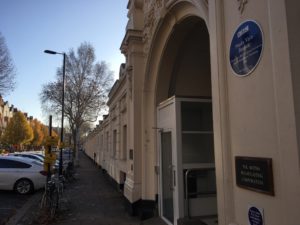
Alas, our final day in London has come. Departing from this lovely, lovely city is always so hard, and I felt that pain of leaving London behind so profoundly on this final day. Marie and Shawn elected to leave one day early in order to have the whole weekend to recuperate, so we had to say our farewells to them in the morning. It was so sad to see them off, and their departure was an agonizing reminder that my time would come the next morning along with Amy’s and Aaron’s. Still, we had much we wanted to see on our final day…
Much of what we had done thus far in London involved visiting lots of very touristy destinations. On our last day, we wanted to get out of the city centre and spend more time with parts of the city that tourists don’t necessarily see. Our first stop was a visit to the Maida Vale Studios, primarily because I wanted to see where the BBC Radiophonic Workshop used to call home (the workshop officially closed in 1998). It’s a large complex dating from 1909 (when it was the Maida Vale Roller Skating Palace and Club), and it was repurposed as recording studios by 1934, becoming one of the BBC’s earliest recording facilities. Not only was this where the BBC broadcasted the news during WWII, this also became home to the BBC Symphony Orchestra. Sadly, the BBC announced in 2018 that the facility would be closed altogether as constant maintenance and its location in a residential area aren’t factors conducive to 21st century recording needs. Even still, it was wonderful to see this large complex, the main entrance alone a lovely sight: an arched passageway with ornate molding.
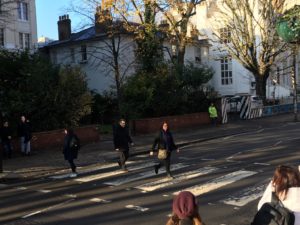
Our next stop involved a leisurely 20 minute walk northeast along the nearby Sutherland Avenue and then Hall Road to Abbey Road Studios. (Yes, obviously those studios that the Beatles made famous in 1969.) Approaching the crossing, we were all struck by how dissimilar it looked compared to the original photo. And while earlier I had mentioned that we were seeking out less touristy locations, this zebra crossing (while not as busy as crossing, for example, Westminster Bridge) definitely attracted a fair share of tourists who wanted to re-create that famous photo. I overheard a local Londoner exclaim as we neared the site, “I never stop for this bloody crossing!” Motorists generally take zebra crossings very seriously, always stopping to allow pedestrians to pass. The rules for this zebra crossing, however, were all thrown out the window, as frequently pedestrians held up traffic in order to take the damn photo. Everyone was acutely aware of this, so they did the best they could to hurry the photo along, but at the same time, there were also everyday pedestrians trying to cross to get to wherever they needed to go, which in turn frustrated them as it’s unclear if motorists will actually stop as they legitimately cross. Of course, if you go to the Abbey Road zebra crossing, do make sure to see Abbey Road studios as well. It’s a modest building that would normally go unnoticed if it weren’t for its iconic history. Nearby the studios is the Abbey Road Shop (a standard gift shop that sells the usual fridge magnets, ornaments, and T-shirts along with, naturally, studio albums), and visitors are greeted with a brief walkway into the shop that has on its left side a short brick wall painted black that has plaques that recount a concise timeline of the studio’s history.
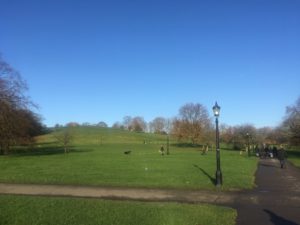
Following Abbey Road, we wanted to pay a visit to Camden Market, upon the suggestion of Marie and Shawn who had visited it twice during their time in London. Abbey Road lies northwest of the city centre and Camden Market is 2 miles away in the northeast, so we almost took the bus to get there (on account of there being no good Underground route which will undoubtedly happen when you visit outside the touristy hub of the city centre), but we decided to walk instead. (This final day in London we ended up walking a record of over 30,000 steps, the most in any single day on our journeys!) The route took us along Prince Albert Road which runs along the north side of Regent’s Park (one of the five large green spaces in London along with St. James’s Park, Green Park, Kensington Gardens, and Hyde Park) and the south side of Primrose Hill, segmenting the two green spaces in two. I had visited Regent’s Park on my previous visit to London but didn’t quite have time to see Primrose Hill, so it was lovely to have accidentally wandered past it on our journey to Camden Town. As the name suggests, the park has a hill that allows for lovely views of not only the city but also the glassy and cylindrical BT Telecom Tower, which still looks somewhat futuristic today (or perhaps futuristic for a Stanley Kubrick film) despite having been built in 1964. Our walk continued by St. Mark’s Church (which had a churchyard full of Christmas trees waiting to be purchased and brought to someone’s home), as well as across Water Meeting Bridge (a modest brick bridge that spans Regent’s Canal).
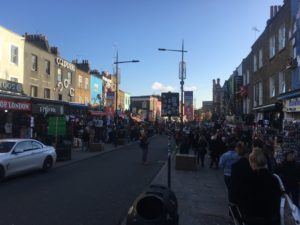
As we neared Camden Town, the streets became slowly more and more busy with pedestrian and automobile traffic, which was actually a little dismaying on account of having just visited the quiet Maida Vale district. If there’s one thing I want to prioritize on my next visit to London it’s that I want to stay away from touristy hubs and visit less well known areas of the city. I don’t want to exclude touristy spots altogether, of course, but rather try to see more of “weird” London, as it were. Visiting Camden Market was a reminder of how many of the things we saw that were popular destinations for lots of people. But I also must admit that Camden Market just wasn’t for us. (Sorry, Marie and Shawn.) It was, indeed, a bustling collection of markets (the Lock Market, Stables Market, Lock Village, Electric Ballroom, and Inverness Street Market are all in close vicinity to each other on the Camden High Street), selling anything from scarves and jackets to jewelry and trinkets, and we barely scratched the surface of the Lock Market (where I did happen to find the perfect messenger bag for myself to help me courier back all the ornaments, books, and teas I purchased while in England; so there’s that, at least) when we all decided that we had enough and made our way back down the high street to the Camden Town Underground station (but not before stopping at an average placed called Dingwalls, where we all had ales with our lunch). In short, if you love shopping, you’ll love Camden Market and you should go out of your way to visit. If you don’t love shopping, you won’t love Camden Market and you shouldn’t go out of your way to visit.
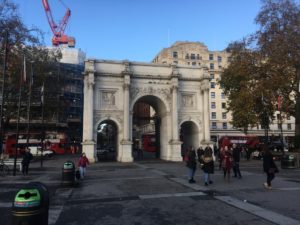
After a ride on the Northern line followed by the Central line, we arrived at Marble Arch on the northeast side of Hyde Park. This arch is comparatively modest after visiting Paris’s Arc de Triomphe, but it’s still worth the trek to view it, as you can combine a visit here with a visit to the nearby Speakers’ Corner. There are several Speakers’ Corners, but the one by Hyde Park is the most famous on account of it being the first such location. It has also been graced by the presence of such notable speakers as Lenin, Carl Marx, and George Orwell. Also nearby is the Animals in War Memorial, a touching monument to animals who served alongside their human soldiers, a solemn stone wall in the shape of an arc that depicts struggling animals with bronze statues of a horse and donkey marching with heavy heads towards a space in the wall.

The sun was already low on the horizon at 2pm as we made our way through Hyde Park. We gazed upon Magazine Cottage, a small, luxurious, brick, two-storey home and for over £1.5 million you too can live right in the middle of Hyde Park; marveled at the Serpentine, a 40 acre lake created in 1730 for Queen Caroline, now home to countless varieties of ducks, geese, swans, and other birds; visited the Holocaust Memorial Garden, a sobering moment as we observed two boulders of differing heights situated amongst silver birch trees, one boulder inscribed with a quotation from the Book of Lamentations; and viewed the Princess Diana Memorial Fountain, a large 50×80 meter oval stream bed constructed of Cornish granite, the water sadly turned off during our visit. We next crossed over into the adjacent Kensington Gardens where we admired the Long Water, technically a western extension of the Serpentine, the two bodies of water separated by the Serpentine Bridge; gazed upon Henry Moore’s stone sculpture, The Arch, a tall marble artwork dating from 1979-1980, designed in a way that makes me think of large human bones; discovered near the Peter Pan statue a tree of flashy green parakeets that might just land on your hand if you’re patient and have food with you; and admired the Italian Gardens, a gift from Prince Albert to Queen Victoria dating from the 1860s that features four shallow but stately fountains surrounded by elegant stonework and decorative urns.
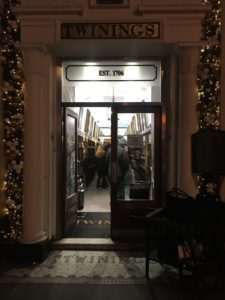
Deciding we had enough of all these serious gardens, we made our way to Fleet Street to do some pub hopping. As I’m writing this post almost a month removed from our final day in London, I can’t for the life of me remember or figure out why we didn’t just take the Central line from Lancaster Gate (a station situation just north of the Italian Gardens) all the way to Chancery Lane (Fleet Street then just a short 10 minute walk south from that station). Somehow we ended up at the Embankment station (which means we would have taken the Central line to Oxford Circus and then caught a Bakerloo line from there to Embankment) and then walked 15 minutes or so to Fleet Street. Regardless, going out of our way to Embankment did allow us one final walk along the Thames. As we made our way toward Fleet Street, we stumbled across a Twinings tea shop on the Strand, where you can purchase any variety of tea that you want. I opted to purchase a large box of strong English breakfast and a tin with a loose leaf Christmas blend of black tea, orange peel, and spices. I know we can get Twinings tea in the U.S., but the quality really is just not the same. I swear, I think they send us bags filled with tea dust that’s been swept off the floor. Amy and I have decided that the only tea worth drinking is the tea directly from England, and we were happy to discover that Twinings ships internationally.
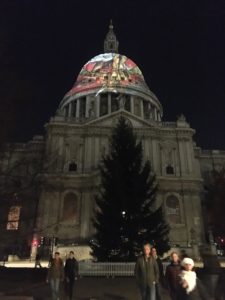
Our evening concluded with some ales at Ye Olde Cheshire Cheese (a pub dating from shortly after 1666 when it was rebuilt following the Great Fire of London), more ales and steak pies at the Old Bell (also dating from the 17th century, built by Christopher Wren who used it to house his freemasons as they were re-building St. Brides Church following the fire), one last glimpse of St. Paul’s Cathedral (which happened to have at the time William Blake’s final work projected on its dome), and then one last walk through Soho to gaze upon London’s magnificent, colorful, bright, creative Christmas displays.
We all keenly felt the pain of leaving London behind as we headed back to our flat in South Kensington for one last night in England. Our adventures here were so absolutely fantastic. We saw so many things, tasted so much food, enjoyed (for the most part) some of the best theatre I’ve ever known, walked over 200,000 steps in just under two weeks, drove hundreds of miles in the countryside, and traveled hundreds of miles by train. Most specifically, however, I miss this city so much as I write this. It is so hard to leave London behind. The sickness I feel when I think about London (the Germans call it fernveh or far sickness, the opposite of home sickness) is sometimes so profound that I become consumed in grief. At the same time, I’ve visited the city three times now, and each of those times are filled with such brilliant and vivid memories of such delightful times that the joy of visiting overcomes the grief of departing. I shall never forget those times, and I’ll cherish them always.
I’ll be writing one last time to provide a brief overview of our adventures, listing everything we did in England and Paris over 13 days (complete with my own personal ratings of all the experiences). I might come up with some interesting statistics as well and also try to compare and contrast my blog posts that covered my visit in 2014 with the posts from this most recent trip, but we’ll see about that.
In the meantime, my dear London: “One day, I shall come back. Yes, I shall come back. Until then, there must be no regrets, no tears, no anxieties. Just go forward in all your beliefs and prove to me that I am not mistaken in mine. Goodbye, London. Goodbye, my dear.”
